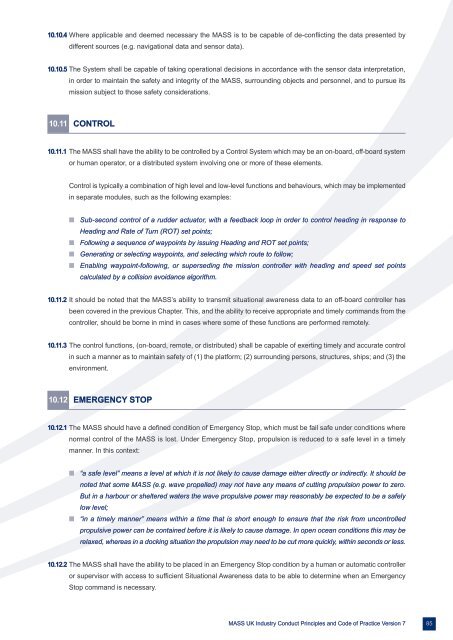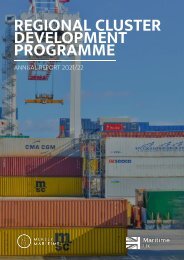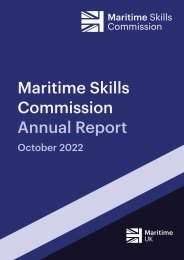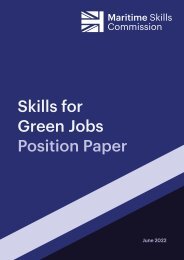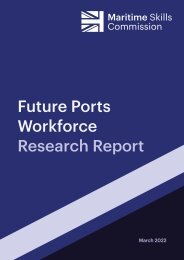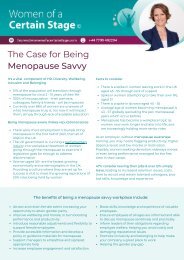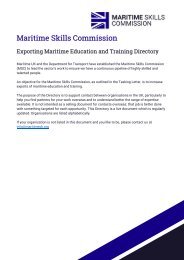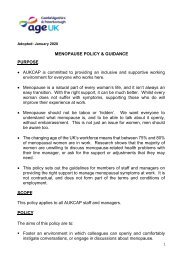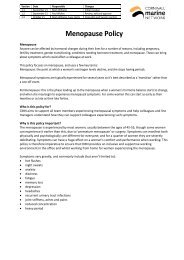COP_2023_V7_pages
You also want an ePaper? Increase the reach of your titles
YUMPU automatically turns print PDFs into web optimized ePapers that Google loves.
10.10.4 Where applicable and deemed necessary the MASS is to be capable of de-conflicting the data presented by<br />
different sources (e.g. navigational data and sensor data).<br />
10.10.5 The System shall be capable of taking operational decisions in accordance with the sensor data interpretation,<br />
in order to maintain the safety and integrity of the MASS, surrounding objects and personnel, and to pursue its<br />
mission subject to those safety considerations.<br />
10.11 CONTROL<br />
10.11.1 The MASS shall have the ability to be controlled by a Control System which may be an on-board, off-board system<br />
or human operator, or a distributed system involving one or more of these elements.<br />
Control is typically a combination of high level and low-level functions and behaviours, which may be implemented<br />
in separate modules, such as the following examples:<br />
n Sub-second control of a rudder actuator, with a feedback loop in order to control heading in response to<br />
Heading and Rate of Turn (ROT) set points;<br />
n Following a sequence of waypoints by issuing Heading and ROT set points;<br />
n Generating or selecting waypoints, and selecting which route to follow;<br />
n Enabling waypoint-following, or superseding the mission controller with heading and speed set points<br />
calculated by a collision avoidance algorithm.<br />
10.11.2 It should be noted that the MASS’s ability to transmit situational awareness data to an off-board controller has<br />
been covered in the previous Chapter. This, and the ability to receive appropriate and timely commands from the<br />
controller, should be borne in mind in cases where some of these functions are performed remotely.<br />
10.11.3 The control functions, (on-board, remote, or distributed) shall be capable of exerting timely and accurate control<br />
in such a manner as to maintain safety of (1) the platform; (2) surrounding persons, structures, ships; and (3) the<br />
environment.<br />
10.12 EMERGENCY STOP<br />
10.12.1 The MASS should have a defined condition of Emergency Stop, which must be fail safe under conditions where<br />
normal control of the MASS is lost. Under Emergency Stop, propulsion is reduced to a safe level in a timely<br />
manner. In this context:<br />
n “a safe level” means a level at which it is not likely to cause damage either directly or indirectly. It should be<br />
noted that some MASS (e.g. wave propelled) may not have any means of cutting propulsion power to zero.<br />
But in a harbour or sheltered waters the wave propulsive power may reasonably be expected to be a safely<br />
low level;<br />
n “in a timely manner” means within a time that is short enough to ensure that the risk from uncontrolled<br />
propulsive power can be contained before it is likely to cause damage. In open ocean conditions this may be<br />
relaxed, whereas in a docking situation the propulsion may need to be cut more quickly, within seconds or less.<br />
10.12.2 The MASS shall have the ability to be placed in an Emergency Stop condition by a human or automatic controller<br />
or supervisor with access to sufficient Situational Awareness data to be able to determine when an Emergency<br />
Stop command is necessary.<br />
MASS UK Industry Conduct Principles and Code of Practice Version 7<br />
85


